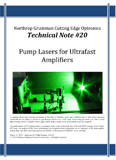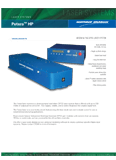Ti:sapphire lasers have become prominent in the field of ultrafast lasers and oscillators due to their broad emission bandwidth and the ability to minimize opto-thermal effects over a wide range of operating parameters. In order to build high-average-power Ti:sapphire lasers, high-quality high-average-power green pump lasers are required.
Cutting Edge Optronics (CEO) offers the Patara-HP family of Q-switched green lasers, which are ideally suited as pump sources for pulsed Ti:sapphire amplifiers. The performance of the Patara-HP pump lasers is examined in this work, particularly the 100W and 200W average power systems. An analysis of pulse energies at varying repetition rates, beam quality and stability, pulse-to-pulse stability, long-term power stability and beam pointing stability is presented. A discussion of laser system reliability is also included.
Pump Lasers for Ultrafast Amplifiers
Faming Xu, Ph.D.[1], G. Jay Doster, Ph.D. and Ryan Feeler, Ph.D.
Northrop Grumman Cutting Edge Optronics, 20 Point West Blvd., St. Charles, MO USA 63301
INTRODUCTION
Titanium-doped sapphire (in short: Ti:sapphire) has become a great workhorse in the area of ultrafast laser oscillators and amplifiers – particularly in the regime of very short pulse durations below 10 fs, where hardly any alternative materials are available. Ti:sapphire has an extremely broad emission bandwidth, allowing the amplification of very broadband ultrashort pulses without much gain narrowing. In addition, the excellent thermal conductivity of sapphire keeps opto-thermal effects at a low level, even for pump powers in the multi-watt regime. As most other broadband laser gain media have relatively poor thermal properties, Ti:sapphire offers a unique performance for use in ultrafast laser systems.
In the most basic case, an ultrafast Ti:sapphire laser system consists only of a mode-locked laser. That has a laser resonator which is often about 187 cm long, such that the round-trip time of pulses circulating in that resonator leads to a common pulse repetition rate of about 80 MHz. Each time the circulating pulse hits the output coupler mirror (one of the two end mirrors), a small portion of its energy transmits that mirror and is obtained as an output pulse. Figure 1 shows a schematic setup.

With a mode-locked Ti:sapphire laser alone, the average output power is typically limited to at most a couple of watts. The simplest way to improve on that is an additional single-pass amplifier, which amplifies the whole pulse train to a somewhat higher power level. Average powers of more than 10 W are possible, although thermal effects then get more and more severe.
As an example, consider an 80-MHz laser with 1 W average output power, corresponding to 12.5 nJ. A single-pass amplifier may directly boost the average power to 5 W, obtaining 62.5 nJ. If the repetition rate is first reduced by a factor 4 to 20 MHz, 5 W already imply 250 nJ. However, amplifying from 1 W / 4 = 250 mW to 5 W already requires an amplifier gain factor of 20 (corresponding to 13 dB), which is quite high for a single-pass amplifier. One may therefore need multiple passes through the amplifier. For example, one can use a set of mirrors to obtain several passes under slightly different directions.
For amplifier gains far above 10 dB, the multipass approach is no longer practical. In that regime, one has to use a regenerative amplifier approach. A regenerative amplifier (Figure 2) has a kind of laser resonator, where a pulse can circulate as in a mode-locked laser. However, an input pulse is injected from some other source (typically, from a mode-locked laser after a pulse picker) in to the amplifier’s resonator, then undergoes e.g. 50 or 100 round trips, and is finally coupled out.
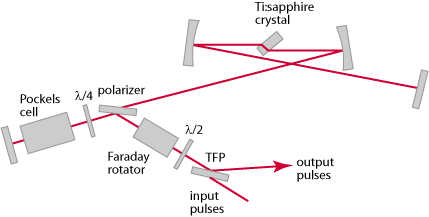
With that approach, the achievable gain is virtually unlimited, as one may realize a large number of round trips. It is no problem, however, to start e.g. with 10 nJ and amplify that to 1 mJ, which means an overall gain as high as 50 dB. If the pulse repetition rate is low enough – e.g. 1 kHz – , 1 mJ correspond to 1 W average power, which is easily possible.
For single / multipass or regenerative amplifier systems with a low pulse repetition rate, a pulsed pump source is required, which is synchronized with the pulses to be amplified. For pulsed operation, a Q-switched neodymium-based infrared laser supplemented with a frequency doubler, as seen in Figure 3, is usually the only option.
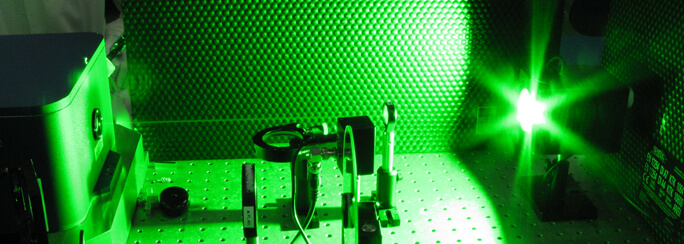
Typical laser gain media for such pump lasers are Nd:YAG and Nd:YLF. These can store relatively large amounts of energy, which one can then easily extract within 100 ns or less. Nd:YLF, having a long upper-state lifetime of 480 µs, is particularly suitable for low repetition rates (e.g. 1-3 kHz), whereas Nd:YAG is otherwise often preferred. In many cases, however, both media are similarly suitable. The green pump power required for a final amplifier stage may be on the order of several hundred watts.
[1] [email protected], (636) 916-4900, http://www.northropgrumman.com/ceolaser
Pulse Energies at Varying Repetition Rates
The Patara-HP100 produces pulse energies of greater than 20 mJ at 532 nm for repetition rates up to 5 kHz, and over 10mJ at 10 kHz. The laser system can be operated at repetition rates up to 50 kHz. The more powerful Patara-HP200 can generate up to 30 mJ at 5 kHz and 20 mJ at 10 kHz. This means that amplifiers with signal output energies of many millijoules can be realized. Figure 4 represents pulse energy and pulse width with respect to (WRT) repetition rate for each respective system.
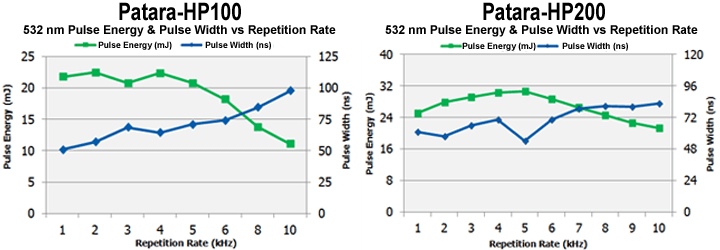
Beam Quality and Stability through the Rayleigh Range
The beam quality is characterized with an M2 factor <20 (Patara-HP100) and <25 (Patara-HP200). This is appropriate for pumping Ti:sapphire amplifiers in this pulse energy regime, where the pump beam does not have to be focused as tightly as for a mode-locked laser. Figure 5 represents typical beam images captured at the output window for each laser system. Figure 6 depicts a close to circular output beam profile with the beam radii in the horizontal and vertical direction differing by less than 10% through the Rayleigh range.
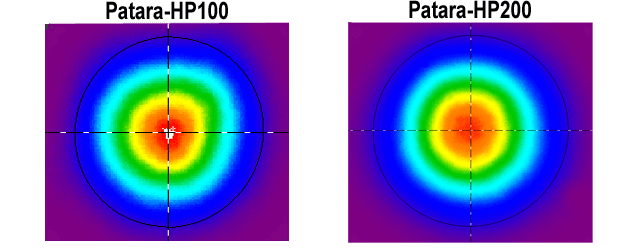
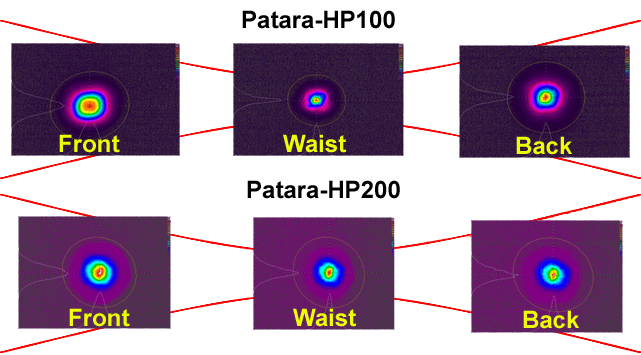
Pulse Width, Pulse-to-Pulse Stability and Timing Jitter
The pulse width for each system is below 150 ns, i.e., far below the upper-state lifetime of Ti:sapphire, and pulse energy for each system exhibits high stability; the pulse-to-pulse energy fluctuations are below 1.5% r.m.s. (Figure 7). Timing jitter, measured by the delay between the external trigger and laser pulse, is only a few nanoseconds for each Patara-HP laser system respectively.

Long-Term Power Stability
The long-term stability (over 8 hours) is less than 2% r.m.s. This is crucial since changes in pump pulse energy would translate into changes of signal pulse energy – particularly in a high-gain amplifier, where the gain depends on the pump pulse energy and gain saturation may not be strong. Figure 8 displays 100-hour stability plots for the Patara-HP100 and Patara-HP200 laser systems.
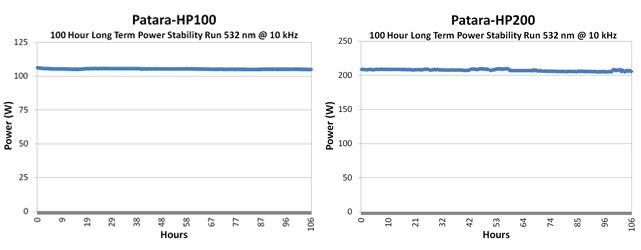
Beam Pointing Stability
Laser pointing stability is defined as an angular value in microradians (μrad). It is a measure of how much the beam position drifts from a target over time. Stability can be affected by a number of factors both internal and external to the laser itself, including physical motion, heat buildup, cavity instability, air currents and more. CEO has measured beam pointing stability for both Patara-HP systems to be ~7.5μrad over a 30 minute period of time. Figure 9 depicts beam stability tracking (measured by beam profiling software) for each system.
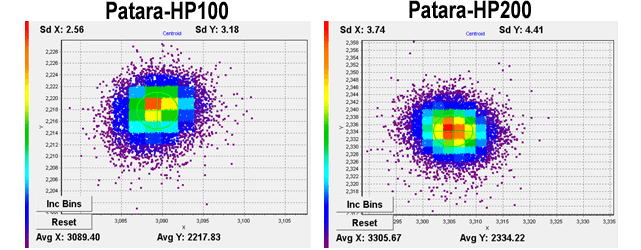
Patara Laser System Reliability
Cutting Edge Optronics is a vertically-integrated laser manufacturer, and controls all aspects of DPSS laser production at its facility in St. Charles, MO, USA. All laser diode arrays that are used in Patara lasers are fabricated in the same facility where the lasers are built. This allows the laser system designers and laser production managers to select diode arrays that are ideally suited for the laser being built.
In addition, CEO pulls sample material from every diode bar lot that flows through the factory. This material undergoes extensive characterization and a subsequent life test. This ensures that every diode array that is used in a Patara laser is of high quality. Records of these tests are maintained for all diode bar lots.
The laser diode arrays are packaged into CEO DPSS gain modules (see Figure 10) and fully characterized before being inserted into a Patara laser. Over 10,000 CEO gain modules have been installed worldwide for commercial, industrial, military and aerospace applications. Laser diode lifetime, in the lasers, routinely exceeds 15,000 hours.

Each component in CEO’s pump lasers is thoroughly cleaned in CEO’s 400 ft² cleaning facility prior to assembly. All lasers are manufactured in a clean, particle controlled environment, and every laser is tested under full shock, vibration and environmental conditions (Figure 11) before it is certified for delivery.

All Patara-HP laser systems are delivered with CEO’s eDrive laser controller electronics, which are also manufactured at the CEO facility. The laser controller features extensive system protection interlocks and on-board diagnostics. All high current circuitry is isolated from low voltage control logic.
Conclusion
With variable repetition rates between 1-50 kHz and pulse energies up to 30 mJ, CEO’s Patara-HP Q-switched green lasers are ideally suited for pumping Ti:sapphire ultrafast amplifiers. Excellent beam quality combined with stable output (pulse to pulse, pointing, and long term) enable rock solid amplifier performance. Lasers from CEO’s Patara product line are operating in several hundred customer sites worldwide, with CEO’s long-lived, high power laser diodes forming the foundation of every laser system shipped from its St. Charles, MO, USA facility. The Patara-HP’s modular design allows it to be custom configured to operate within various application platforms. The Patara-HP100 and Patara-HP200 laser systems have been successfully installed as pumps for a variety of regenerative and multi-pass ultrafast amplifier systems.
CEO also offers a short pulse, high energy Q-switched green laser system for pumping Ti:sapphire at repetition rates on the order of 100 Hz. The Gigashot Green produces 150 mJ, 10 ns pulses at 110 Hz, 532 nm. This laser system is designed with an externally-doubled unstable resonator cavity, and can be seeded as well as amplified to >2 J (green) with the addition of CEO’s REA amplifier modules. Additional repetition rates are also available within a broad range of 10s of Hz to 100s of Hz.
Backed by an experienced team of scientists and engineers, CEO’s Technical Services group ensures that all Patara-HP and Gigashot laser systems perform to all customer expectations upon installation and throughout its long lifetime. CEO is dedicated to providing the highest quality products and services with the highest value to the customer.
Approved for Public Release 14-0532
© 2014 Northrop Grumman Systems Corporation – All Rights Reserved


